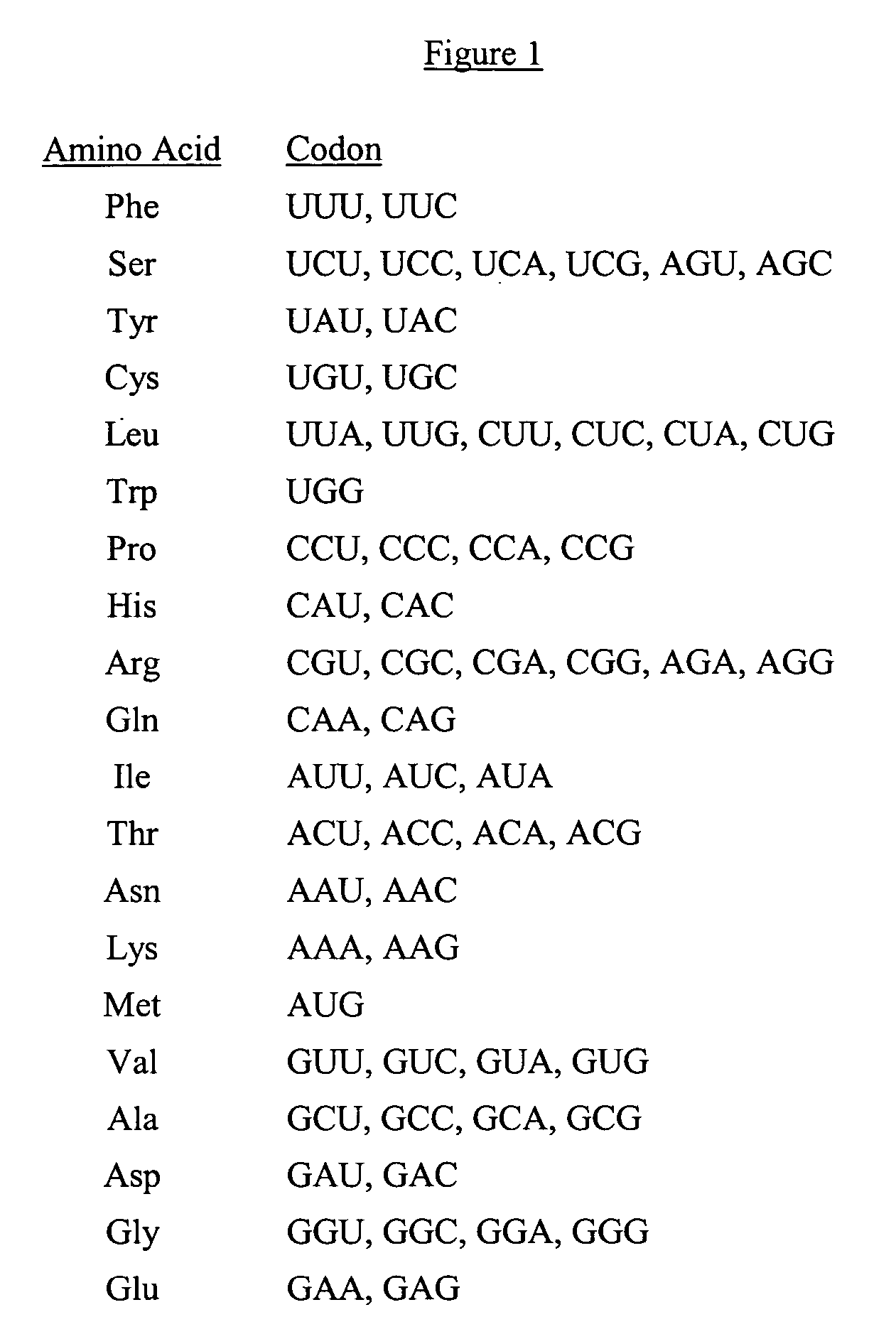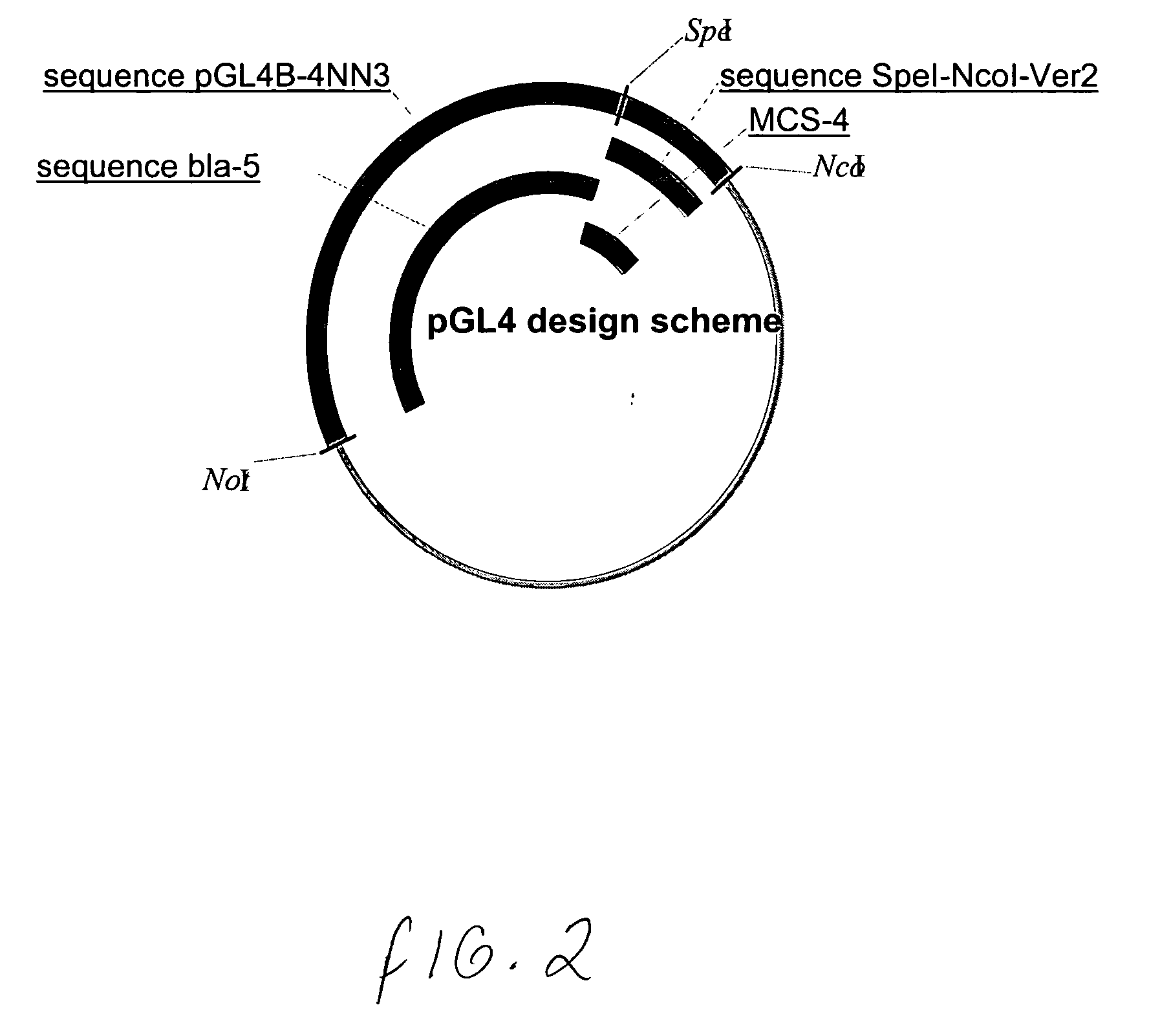Synthetic nucleic acid molecule compositions and methods of preparation
- Summary
- Abstract
- Description
- Claims
- Application Information
AI Technical Summary
Benefits of technology
Problems solved by technology
Method used
Image
Examples
example 1
Synthetic Click Beetle (RD and GR) Luciferase Nucleic Acid Molecules
[0107] LucPp / YG is a wild-type click beetle luciferase that emits yellow-green luminescence (Wood, 1989). A mutant of LucPplYG named YG#81-6G01 was envisioned. YG#81-6G01 lacks a peroxisome targeting signal, has a lower KM for luciferin and ATP, has increased signal stability and increased temperature stability when compared to the wild type (PCT / WO9914336). YG #81-6G01 was mutated to emit green luminescence by changing Ala at position 224 to Val (A224V is a green-shifting mutation), or to emit red luminescence by simultaneously introducing the amino acid substitutions A224H, S247H, N3461, and H348Q (red-shifting mutation set) (PCT / WO9518853) Using YG #81-6G01 as a parent gene, two synthetic gene sequences were designed. One codes for a luciferase emitting green luminescence (GR) and one for a luciferase emitting red luminescence (RD). Both genes were designed to 1) have optimized codon usage for expression in mamm...
example 2
Synthetic Renilla Luciferase Nucleic Acid Molecule
[0224] The synthetic Renilla luciferase genes prepared include 1) an introduced Kozak sequence, 2) codon usage optimized for mammalian (human) expression, 3) a reduction or elimination of unwanted restriction sites, 4) removal of prokaryotic regulatory sites (ribosome binding site and TATA box), 5) removal of splice sites and poly(A) sites, and 6) a reduction or elimination of mammalian transcriptional factor binding sequences.
[0225] The process of computer-assisted design of synthetic Renilla luciferase genes by iterative rounds of codon optimization and removal of transcription factor binding sites and other regulatory sites as well as restriction sites can be described in three steps: [0226] 1. Using the wild type Renilla luciferase gene as the parent gene, codon usage was optimized, one amino acid was changed (T→A) to generate a Kozak consensus sequence, and undesired restriction sites were eliminated thereby creating synthetic...
example 3
[0271] Synthetic Firefly Luciferase Genes
[0272] The luc+gene (U.S. Pat. No. 5,670,356) was optimized using two approaches. In the first approach (Strategy A), regulatory sequences such as codons were optimized and consensus transcription factor binding sites (TFBS) were removed (see Example 4, although different versions of programs and databases were used). The sequences obtained for the first approach include hluc+ver2AF 1 through hluc+ver2AF8 (designations with an “F” indicate the construct included flanking sequences). hluc+ver2AF1 is codon-optimized, hluc+ver2AF2 is a sequence obtained after a first round of removal of identified undesired sequences including transcription factor binding sites, hluc+ver2AF3 was obtained after a second round of removal of identified undesired sequences including transcription factor binding sites, hluc+ver2AF4 was obtained after a third round of removal of identified undesired sequences including transcription factor binding sites, hluc+ver2AF5...
PUM
| Property | Measurement | Unit |
|---|---|---|
| Fraction | aaaaa | aaaaa |
| Fraction | aaaaa | aaaaa |
| Fraction | aaaaa | aaaaa |
Abstract
Description
Claims
Application Information
 Login to View More
Login to View More - R&D
- Intellectual Property
- Life Sciences
- Materials
- Tech Scout
- Unparalleled Data Quality
- Higher Quality Content
- 60% Fewer Hallucinations
Browse by: Latest US Patents, China's latest patents, Technical Efficacy Thesaurus, Application Domain, Technology Topic, Popular Technical Reports.
© 2025 PatSnap. All rights reserved.Legal|Privacy policy|Modern Slavery Act Transparency Statement|Sitemap|About US| Contact US: help@patsnap.com



